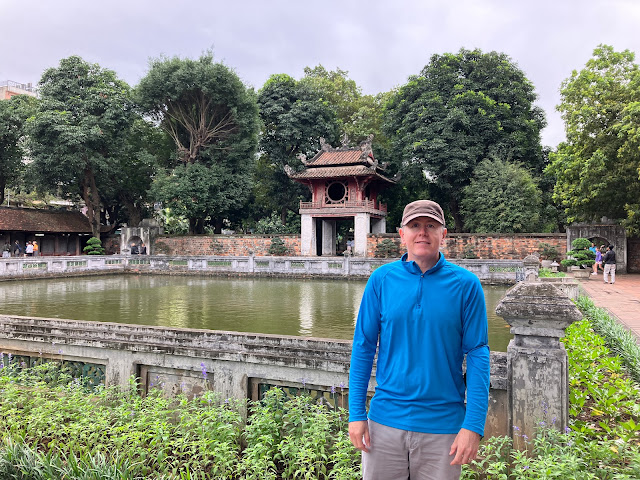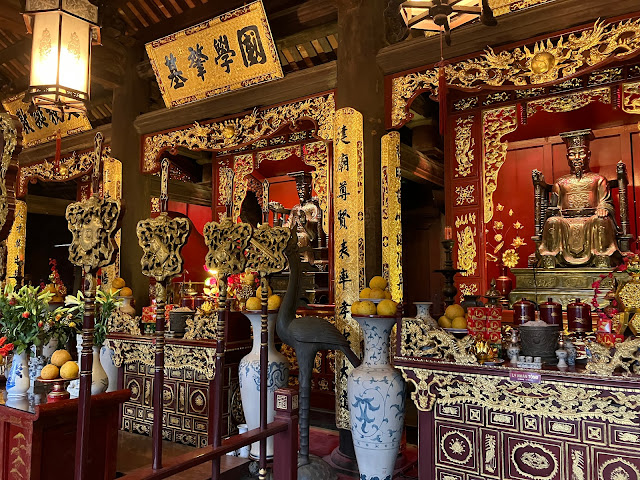We arrived in Hanoi on a Sunday evening, which meant we had a chance to visit the weekend night market in Old Town Hanoi.
For the market the normally hectic streets were closed to car and motorbike traffic so it was easy to walk around. The vendors selling the elaborate 3D paper pop-up cards were my favorite.
Our hotel is right near St. Joseph’s Cathedral. Since it was a Sunday night they held several masses, which were so well-attended that some of the congregation had to sit outside in the square.
In between services, we were able to take a look inside. Saint Joseph is the patron saint of Vietnam. The cathedral was completed in 1886, about a decade after the French occupation began. To build it, the French cleared away the ruins of an ancient 11th century pagoda that collapsed in the 1500s. We can hear the church bells from our hotel room in Hanoi, and have a nice view of the bell towers from the hotel roof. Here is what the inside of the church looks like (we managed to go inside in between masses).
One of the first things we wanted to do in Vietnam was to take a food tour. Kevin found a really good one, led by a local guide named Minh. He took us to seven different shops, each serving a different specialty — including Phở gà (noodles with chicken), Bún Chả (noodles with pork), and Bánh Xèo (a type of crispy rice pancake filled with seafood). Don't ask me how to pronounce any of those, but I can definitely say they were all delicious! There was one other nice couple on the tour, so it was a small group and we were able to squeeze into some tight places. We joked that the stools around the tables got smaller and smaller as the afternoon went on.
All of the food we tasted was excellent. I really like the mix of herbs and sauces that are usually included with each dish — it lets you flavor the food to your liking and control the spice level. We learned how to roll our own Nem Nướng (summer rolls - rice paper filled with pork, herbs, rice noodles, and crunchy julienned vegetables).
And of course we sampled some of the local beers. We walked through “Bia Corner” which was deceptively low-key in the early afternoon. As the afternoon wears on, many small bars will open and this place will be much livelier in the evening.
After the food tour we walked around the Hoàn Kiếm Lake (also known as "lake of the returned sword") and the French quarter. The Đền Ngọc Sơn Temple is on an island in the lake, connected by the beautiful red Cầu Thê Húc Bridge ("light of the dawn" bridge). Here's what the bridge looks like lit up at night.
The temple has an interesting story behind it that is very important to Vietnamese people. Legend has it that when the Vietnamese were at war with China, the Vietnamese emperor was given a magical sword that helped him defeat the enemy. After the Chinese were defeated, the hero was boating on the lake when a giant golden turtle surfaced to reclaim the magic sword. The sword was returned into the lake, and the country prospered.
The lake was once the home to two giant softshell turtles (the largest freshwater turtles in the world), which were associated with the legend due to their long lifespan. The first one sadly passed away in 1967. The last remaining turtle in the lake died in 2016. They preserved both turtles and now they are venerated in a small chapel of the temple. Unfortunately this turtle species is critically endangered — there are only 3 left in the wild, and just a handful left in zoos.
Hanoi used to be the capitol of French Indochina. The French had a Catholic Jesuit presence here beginning in the 1700s, and then in the mid-1800s France began a military campaign in the country to take more territory and stop persecution of the Catholic missionaries. Vietnamese resistance to French occupation was strong, there were many rebellions. France held on to the territory until the Japanese took it during WWII, after which bitter fighting began over who would control the country. That conflict grew over decades and culminated in the Vietnam War. There are many examples around Hanoi of French colonial architecture, one of the most visited is the Hanoi Opera House, completed in 1911 and modeled after the Palais Garnier in Paris.
Opera isn't really our thing but we did have a chance to see a different kind of show while we were here. Hanoi is home to two competing water puppet theaters. We got tickets to see the oldest troupe perform this traditional entertainment.
This art form evolved a thousand years ago when farmers used the water-filled rice paddies as theaters to celebrate the end of the harvest. From behind a screen, puppeteers stand waist deep in a pool of water and manipulate the wooden puppets in front to tell a story. The action is set to traditional Vietnamese music. The puppeteers are able to move the puppets in creative ways, making them jump, swim, climb trees, and there were even a couple of fire-breathing dragon puppets. The puppets are all hand-carved and hand-painted -- each one is unique.
On our last morning in Hanoi we walked to the Hoa Lo prison, which might be better known by the name American POWs used to describe it — “the Hanoi Hilton”.
The prison has a history that stretches back much further than the Vietnam War though. It was originally built by the French and was used to house Vietnamese dissidents opposed to French colonial rule. Prisoners were treated quite harshly, put in leg irons and existing in unspeakably inhumane conditions.
In the exhibition about the Vietnam War POWs, the museum explained that the American prisoners were treated much better by the Vietnamese than the Vietnamese prisoners were treated by the French. It isn’t clear to me how much truth there is in those claims; I have added some books by former POWs to my reading list to learn more. But what is clear is that that the war in Vietnam left many lives forever changed.
On another day, we were able to walk to the spot next to hồ Trúc Bạch lake where John McCain parachuted and was dragged out of the water in 1967 after his plane was shot down in the Vietnam War. There is a small monument noting the event from the Vietnamese perspective. According to Wikipedia the inscription translates to "On 26 October 1967 near Truc Bach Lake in the capital, Hanoi, the citizens and military caught Pilot John Sidney McCain. The US Navy Air Force Aviator was flying aircraft A4, which crashed near Yen Phu power station. This was one of ten aircraft shot down that same day."
One of the most interesting places we visited in Hanoi was the 11th century Temple of Literature. Pathways lead the visitor through a series of five courtyards and ponds. The courtyards have names that translate to phrases like "Courtyard of Great Success".
The temple was built as an imperial academy where students would study history, literature, and poetry and take various exams to become magistrates and bureaucrats. The temple is dedicated to Confucius, and there are also statues of three kings who championed education and prioritized the university/academy.
The temple is extremely important for Vietnamese historians because of the stone steles dedicated to the successful doctoral candidates. Each of these 15th-century steles has an inscription with the names of the doctors who matriculated that year and many details including dates, who ruled the kingdom, which mandarins administered the exams, etc. So each stone turtle carries a relic of Vietnamese history on its back.
Since we were delving into ancient history we also visited the Imperial Citadel of Thang Long. This palace was mostly destroyed during the French occupation. Now there are active archaeological excavations happening behind the reconstructed fortress.
One of the unique structures that had been preserved is the “descending dragon” staircase in front of what used to be the palace in the forbidden city. The carvings of the two dragons date back to the late 1400s.
We finished our day by trying a Vietnamese egg coffee and some coconut ice cream at a fancy coffee shop near our hotel. Egg coffee is made by whipping egg yolks with milk and sugar, boiling the mixture, then pouring coffee over it until it foams. It's a little bit sweet but not too sweet. Kevin had that while I had a regular Vietnamese coffee sweetened with condensed milk, which was incredibly sweet. Both kinds of coffee were delicious, as was the coconut ice cream served in a hollowed-out coconut. Sugar overload!
We only had a brief couple of days to explore Hanoi, but hopefully we saw the highlights. I think you could spend several weeks here and never see it all. We are looking forward to getting outside the chaos of the city to see a little bit of northern Vietnam's natural beauty later this week.
























No comments:
Post a Comment